More about Thimbles





Magdalena and William Isbister.
In 1989 Holmes described the ‘instant thimble’ (1). These are porcelain thimbles with pictorial transfers on sentimental themes: garden birds, Dutch flowers, baby animals of the world, cats etc. According to Holmes ‘they sell for pounds 8 - pounds 10 each and then, when the collector dies and the collection is auctioned, they fetch as little as 10 for pounds 1.’ (2). We wish to add another term to the thimble literature – the ‘hybrid thimble’. The hybrid thimble is not a fake in as much as it does not attempt to copy any previously made worthy thimble (Figs 1 & 2), but rather it is a thimble made from old and new parts combined into a hybrid form which as a result is like no other ‘original’.


Fig 1 Fig 2
In this paper we will describe some of the ‘hybrid thimbles’ that we have come across during our time collecting thimbles.
Many years ago we bought a ‘Russian’ thimble in Sydney. It was rather unusual in that it had a stone top and we were rather excited about our find (Fig 3). We were also rather inexperienced in those days and did not realise that smooth undimpled stone tops were pretty useless for sewing. We did not know either that the Russians did not usually use stone to top their thimbles and ion all probability the thimble was made in Germany.

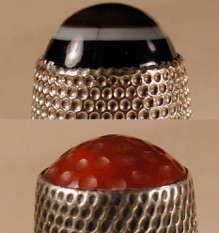
Fig 3 Fig 4
Some years after this purchase the idea of the ‘hybrid thimble’ was born in our minds and when we examined the ‘Russian’ thimble more closely it was possible to see that the stone was not only not dimpled but that the mounting was made from the irregular top edge of the dimpled border (Fig 4). Clearly the original top had been damaged and replaced by a rather elegant cabochon stone.
Early Dorcas thimbles were tall with rounded tops (Fig 5) but our ‘hybrid’ Dorcas has a hand dimpled ‘new’ flat top (Fig 6).
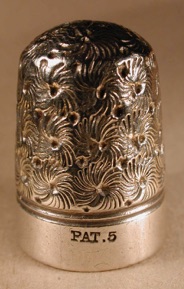
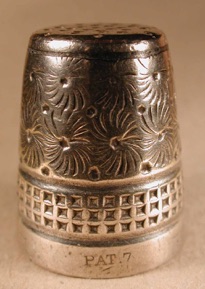
Fig 5 Fig 6
Whilst searching for thimbles in Warsaw in 1992 we came across an elegant antique shop in the old town and were offered two ‘Russian’ thimbles. This time we did know that they were ‘hybrids’ but we thought that they were interesting in spite of their hybridisation.
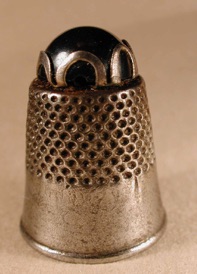
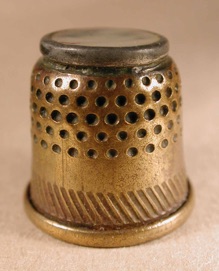
Fig 7 Fig 8
The first one (Fig 7) was a simple steel thimble with a black bead mounted on the top and held in position by six steel loops. The second was an older brass thimble with a metal mounted ‘mother of pearl’ button soldered to the top.
Our next ‘hybrid’, bought in New Zealand, also had a stone top but not only did the stone top have no indentations, it was flat!
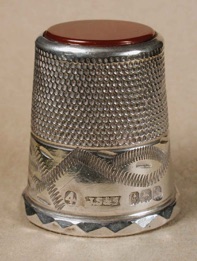
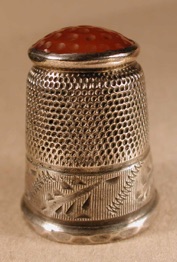
Fig 9 Fig 10
The stone was not backed but it was clear that the original thimble was supposed to have had a stone top (Fig 9). As far as we have been able to ascertain however James Swann and Sons of Birmingham never made thimbles with flat smooth stone tops and so this must be a ‘hybrid’. Fig 10 shows how the thimble is more likely to have looked in its original state.
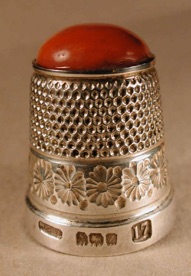
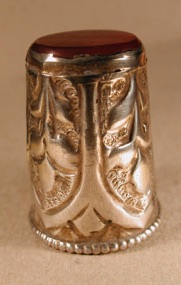
Fig 11 Fig 12
On the thimble in Fig 11 the stone has the correct mounting but the stone has no indentations and the thimble is therefore a composite of old and new. It is not the authors intention to suggest that all non dimpled stone tops are to be found in ‘hybrid thimbles’ as the original example from Afghanistan shows (Fig 12). In this thimble the stone is flat, there are no dimples and it is highly unlikely that the thimble was made for any use other than as a souvenir.
Our next ‘hybrid’ was bought on Ebay and clearly from the Ebay ‘listing’ there was something wrong! When the thimble arrived we could examine it carefully (Fig 13).
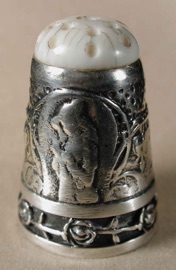
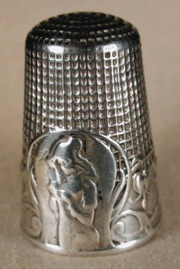
Fig 13 Fig 14
The top was made of ‘ivory’ and hand indented, it was backed. The border seemed to be a very worn version of the border of the French thimble (Fig 14) made at the beginning of the 20th century, probably by Jules Levy in Paris, and called ‘La jeune fille au crochet’ (‘Golden Hands’ in Anglo-Saxon). The border was applied and comprised a band of finely sculptured roses.
Two examples of the silversmith’s craft follow. The first thimble, made by Rene Lorillon in Paris at the beginning of the 20th century had a damaged silver dimpled top. The top was carefully removed and the top edge of the dimpled border was finished to make the thimble look like an original ‘tailors’ thimble. Rene Lorillon did not make tailors thimbles! Whilst nothing has been added to this thimble it has been included to show how a good silversmith can salvage an old thimble (Fig 15).
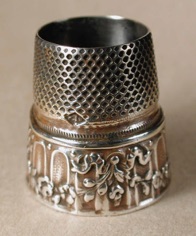
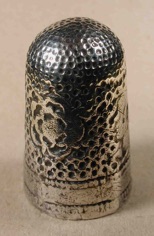
Fig 15 Fig 16
Careful examination of the 17th century English thimble shown in Fig 16 will show that the top dimpling is slightly finer than the dimpling on the border. The top dimpling is not so regular either and, in fact, the original thimble was excavated without a top and the top has been recently made. Neither of these thimbles was ‘treated’ to deceive but rather because of their interest they were ‘mended’ and so became hybridised.
In 1905 Charles Horner had this thimble (Fig 17) assayed in Chester. It is not thought that Charles Horner ever made thimbles with stones but that a few of his thimbles were ‘hybridised’ by another jeweller at some time after they were made as a special order (3).
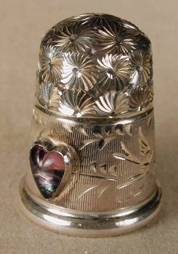
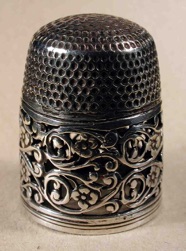
Fig 17 Fig 18
Our last ‘hybrid’ clearly has a simple machine dimpled top, as one would see on many English silver thimbles from the early part of the 20th century. The ajouré work rim was probably made in Israel and has been clumsily soldered to the old top (fig 18). This is clearly not an old English thimble and is a true ‘hybrid’.
‘Hybrid’ thimbles have been found on the internet (Figs 19, 20) and in sales magazines. Interestingly between 1987 and 1992 we found two TSL magazines with what we thought were ‘hybrid’ thimbles but between 2003 and 2007 we found seven magazines with such thimbles. Considering the number of thimbles on sale during this period in the magazine the percentage of ‘hybrids’ was very small but the fact that the numbers are increasing may signify an attempt to fill a need in the absence of the real thing. ‘Hybrid’ thimbles have been reported in the thimble literature too (4) although it would seem that the owners did not seem to have realised their error.
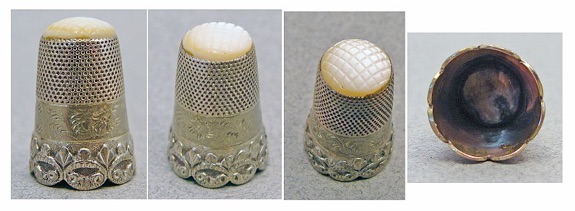
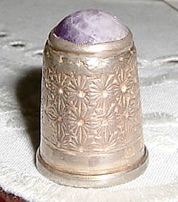
Fig 20
It is our conclusion that many of our ‘hybrid’ thimbles were not made primarily to deceive because they were not sold for very high prices. They are, in most part, someone’s attempt to fashion a repair to a damaged thimble in order to make it more pleasing to the eye. The process of ‘hybridisation’ can however be used to create what looks like an old thimble and would be buyers should be aware of the ways in which the original thimbles were made (i.e. original European stone tops are not flat or smooth!). Some hybrids were created for decorative purposes and a few were undoubtedly made to secure a high price. The prospective buyer must beware and know of ‘hybridisation’.
References
1. Holmes E F. Thimble Notes and Queries, 1989; 4: 19.
2. Windsor J. Learn to play your cards right. The Independent, London October 15, 1995
3. McConnel B. The story of the thimble. Atglen, PA.: Schiffer Publishing Ltd, 1997. pp. 113.
4. Mohr G, Mohr G. Rund um den Fingerhut, 1996; 24:27.
TCI Bulletin Winter 2009
Holmes: ‘Thimble Rigging’ pp. 220.
Addendum (2011)
Recently a new type of 'hybrid' thimble has emerged. We have chosen to call it the 'extended hybrid' because the thimble comprises an original 'normal' length thimble to which an additional plain or decorated rim has been attached. The thimble thus looks too long and it is difficult to know why this modification has been made to what seems to be a perfectly undamaged thimble otherwise. The hybridisation has not been undertaken to replace a missing stone or other damage to the thimble.
The gold thimble seems to have had an additional brushed gold rim added and now looks out of proportion.
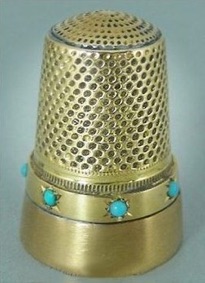
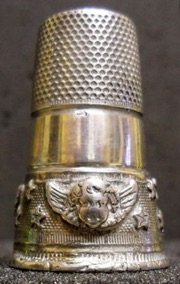
Th French silver thimble has clearly had the decorated rim of another French thimble added to what was a very plain and simple silver thimble. Interestingly the Paris assay office 'boar's head' mark may be seen on the original thimble above the rim and another maker's mark was found on the added rim.
Addendum (2012)
An example of a hybrid thimble in which a repoussé border has been added to a stone topped silver thimble was found for sale on Ebay. The original thimble was probably made in Germany.

The four oval carnelian cabochons have clearly been added to this, possibly, French thimble in order to 'glamorize' it. The mountings are not in the same style as the other decoration on the border.
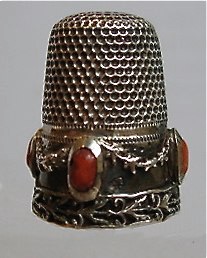
Researched and published in 2002/11
Copyright@2011. All Rights Reserved
Magdalena and William Isbister, Moosbach, Germany
‘Hybrid’ thimbles
Navigation
